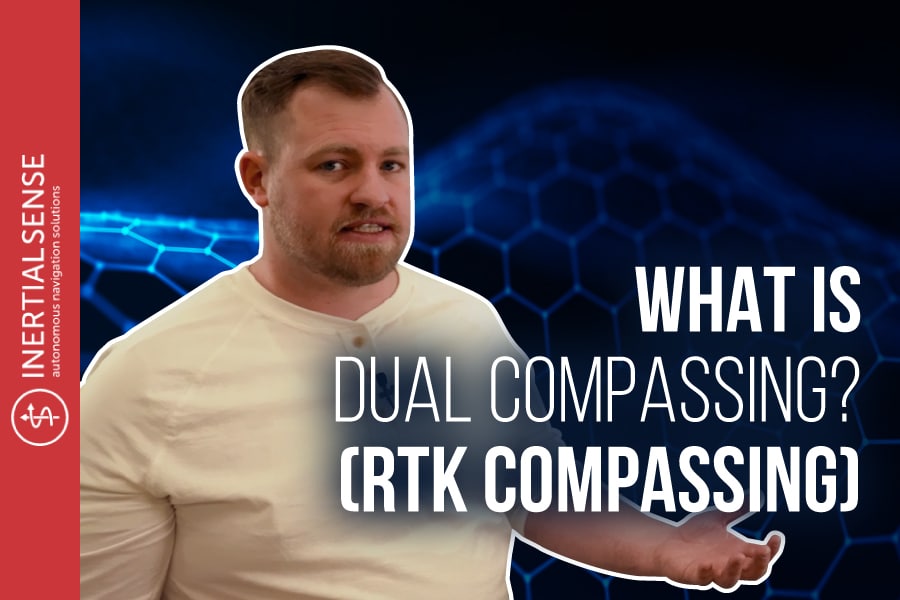
What is Dual Compassing? (RTK Compassing)
GPS Compassing is taking two GPS antennas and using them on a baseline with one another to give a heading. Watch the video below as Carson explains how RTK and dual compassing work together.
Inside a sensor, the IMU contains a magnetometer. This sensor tells the system which direction it is facing and gives it the heading. A magnetometer uses true North, but true North has a 2-degree error rate, meaning that when it is pointing in one direction, there are things or factors involved that affect accuracy. Having moving metal parts can also affect that accuracy. With this in mind, the magnetometer is never going to point the exact direction you want it to.
The benefit of using dual compassing is you can cancel out the magnetometer and use it as a fallback and you can put two GPS antennas on top of a robot for a baseline. If they are one meter apart, your accuracy will be 0.3 degrees. Your accuracy goes from 2 degrees using a magnetometer that has interference from motors and moving metal parts. You are now using a GPS-based system, and it gives a 0.3 degrees accuracy, which is significantly higher than that of the magnetometer.
Many applications that are used are stationary. Unfortunately, the current system at Inertial Sense is unable to combine RTK and dual compassing simultaneously. Because of this, we highly encourage the use of this system when your application is stationary with moving metal parts. Instead of using the magnetometer, dual antennas are placed on the system to improve accuracy. This way, the antenna is pointing as close to the exact direction as possible.
We are currently working on a product that will be able to work with RTK and dual compassing. Give us a call at Inertial Sense for more information.
Learn More:
What Is RTK and Why Do I Need It?
Video Transcription
GPS Compassing is taking two GPS antennas and using them on a baseline with one another to give yourself a heading.
Inside of the sensor, the IMU contains a magnetometer. This sensor tells the system which direction it’s facing. It gives it it’s heading. A magnetometer uses true North. True North has a 2-degree error rate, meaning that when it’s pointing one direction, there’s so many things or so many different factors involved in it, that it’s not always accurate. And one of those inaccuracies can come from moving metal parts.
When you’re building a robot in an autonomous system, it is very likely that you’re going to be using moving metal parts. Whether it’s a motor or an engine or whether it’s an antenna that’s revolving around the top. There’s a lot of different uses for metal parts inside of your machine.
So if that’s the case, this magnetometer is never going to be pointing the exact direction you want it to.
The benefit of using dual compassing is you can cancel out the magnetometer and just use it as a fallback. And you can put two GPS antennas on top of this robot on a baseline. And if they’re one meter apart, your accuracy is 0.3 degrees. So it goes from 2 degrees using this magnetometer that has all of this interference from the motors and the moving metal parts. And you’re able to take that, you’re no longer using a magnet-based system. You are now using a GPS-based system, and it’s giving you 0.3 degrees accuracy, which is significantly higher than that of the magnetometer.
A lot of the applications that use it are applications that are stationary. This is because unfortunately our current system, we’re unable to do RTK and dual compassing simultaneously. Because of this, we highly encourage the use of this system when your application is stationary with moving metal parts.
So antenna pointing is a big one.
A company has this big antenna, ok, pointing towards the sky. They want as high accuracy and heading as humanly possible. And so instead of using the magnetometer, they’re going to put dual antennas on this system to improve the accuracy. That way, this antenna is pointing as close to the exact direction as they want it to.
One of the most complicated things with using dual compassing is we’re unable to use RTK and dual compassing simultaneously. We are rolling out a product that will be able to do that. So I highly encourage you to give me a call.

